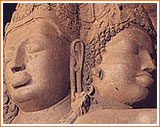Ajanta Caves Tour

The Ajanta Caves are at a distance of 100 km from Aurangabad in the state of Maharashtra India. After being in oblivion for centuries, the caves were discovered by chance in 1819 by a British hunting party. The remarkable Ajanta caves are listed as a UNESCO World Heritage Site.
A tour of the Ajanta caves will make you marvel at the architectural and artistic capabilities of that period. The total number of caves including the unfinished ones is 30, out of which Caves No. 9, 10, 19, 26 and 29 are chaitya caves and the rest are viharas of the monasteries. The caves are hewed out of granite cliffs on the inner side of a 20 m long ravine along the Waghora River.
The caves can be divided into two distinct phases with a gap of almost four centuries between them. The caves of the first phase can be dated to around the 2nd century BC. The caves of the second phase belong to the period of the Vakatakas and the Guptas. The caves are noteworthy for their rock-cut architecture as well as fine paintings on the walls of the caves. The themes of the paintings are from the incidents in Buddha's life, and depict Bodhisattvas and episodes from the Jatakas.
You will learn about the tempera technique of painting on the tour of Ajanta Caves since the images are painted on a dry surface. The walls of the rock were coated with a 1 cm thick layer, which consisted of a mixture made of clay, cow dung and rice husks. A final coat of lime was applied to produce the finished surface on which the artist painted. The color was made from natural products. These beautiful paintings have managed to survive till today.
The caves are divided into Hinayana and Mahayana caves. The Chaitya Caves Nos. 9 and 10 and Vihara Caves No. 8, 12, 13 and 15 are Hinayana Caves. The Vihara Caves Nos. 1, 2, 16 and 17 and Chaitya Caves No. 19 and 26 are Mahayana Caves. The Caves influenced by Hinayana Buddhism have paintings in which Buddha is represented by his symbols while the caves influenced by Mahayana Buddhism depict Buddha in his human form. The caves are numbered to their access from the entrance. A modern terraced path connects the caves. In the original construction, each cave was accessed from the riverfront by individual staircases.
The location
The caves are in the state of Marathas, Maharashtra, 100 kilometers from the city of Aurangabad. The caves are by the river Waghora, in the midst of the Sahyadri hills buried by thick forest all around. The Ajanta Caves were discovered by a British Captain, John Smith in 1819, and while on a hunting expedition.
Buddhist Attractions in Ajanta CavesThe Ajanta caves are important mainly to see the fine line of transfer of the Hinayana and the Mahayana sect, as for the fact he Hinayana did not worship any god or goddess but they used stupas, and other rock forms to represent Buddha. Mahayana on the other hand, used idols of people they worship. Interestingly, the caves include both Chaitya (Prayer Halls) and monasteries and have both types of architecture and art besides paintings and scriptures, of the two sects Hinayana and Mahayana. Caves numbered 8,9, 10, 12, 13 and 15 are of the older sect, Hinayana. Mahayana related caves are numbered 1, 2, 16, 17, 19 and 26 where, 19 and 26 are Chaityas.
There are some unsurpassable paintings in the caves 1 and 2, mainly depicting the Jataka Tales. Buddha preaching in sitting position is the other common example of sculptures. Cave 10 is also quite attractive for its Buddha images and the depiction of Jataka tales. Cave 16 and 17 are monasteries full with images of Jataka tales, child and youth of Buddha, the Sravasti tales etc. and are good examples of architecture. Caves 1, 2, 3,5,6,8, 14, 15, 16 and 17 are Viharas or monasteries, 19 and 26 are prayer halls while caves 20 to 25 were used for residential purposes.
Though all the caves are interesting to watch and noteworthy, if one has only a little time in hand caves, remember 1, 2, 16, 17, 19 and 26 are must see.
How to reachBy Air : Aurangabad, 100 kms away is the nearest airport. Direct flights available from Delhi, Mumbai, Jaipur etc.
By Rail : Aurangabad is nearest railhead, Jalgaon, 59 km away, is good for catching swanky trains.
By Road : Well-maintained roads link Ajanta to Mumbai, good buses are also available. Ajanta- 100 kms, Bombay- 390 kms, Ellora- 32 kms, Nanded- 275 kms, Nasik- 224 kms, Pune- 232 kms.









